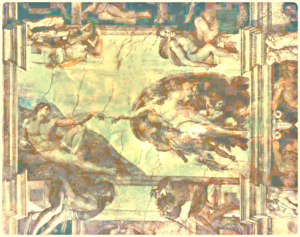Taurus the constellation
Vrisha Mandala – Guttana (the heavenly bull), Aleph, Alap-Samé, Taburi, Burj Al Tawr, of the bull. Made up of 44 stars. Taurus.
Alpha – Alderberan/Ad Dabaran – one who follows. Ain el Tawr – eye of the bull. – Rohit – Bir (the vermillion) – Oculus Tauri (eye of the bull) – Suravi – Haladdi-varna.
Beta – Nath – Agni – Al-natih (the Butting) – Kabdhi-I-inan ( the heel of the rein holder)
Zeta – Svaha
Eta (25) – Alcyone (queen who wards off evil storms) – Devasena
Gamma – Primus Hyadum, first Hyad.
Epsilon – Ain, (Second eye of bull)
27 (Tauri) – Atlas, he who dares and suffers, father of Plieadian set
17 (Tauri) – Electra – Amber, shining, bright
20 (Tauri) – Maia – grandmother, mother, nurse, great one
23 (Tau) – Merope – Eloquent, bee-eater, mortal
19 (Tau) – Taygeta – long-necked
28 (Tau) – Pleione – Sailing queen – Ocean creature, mother of Plieadian set
16 (Tau) – Celaeno – Swarthy
21/22 (Tau) – Asterope – Lightning, twinkling, sun-faced stubborn face
Other Asterisms inside of Taurus
A cluster – Hyades/ Huēin – to rain.
Suculae / Hues – Sow.
7 stars – Plieadies/Plein – To sail. Their many names are the following –
Alcyone, Merope, Celieno, Electra, Maia, Asterope, Taygeta. Also collectively known as
– Eth Thoreyya/Et Tawr.
– Hesperides, Atlantides
– Virgirlae – stars of spring.
– Cleaver, hencoop, Kimah
Alcyone – The hen. (Deva-sena).
Krittika nakhatra – Matri mandala – Mula(the star) – Te (the foundation) – Mao (sun-open door) – Kimah (family) – Aritum (The cluster) – Virgilae (stars of the branches) – Pleiades (the numerous). 3rd Nakshatra.
Deity – Agni. Matri mandala is a cluster of 400 stars, 6 to 8 of which are visible. 6 of these constitute Krittika, in the shape of a fire-flame. Krittikas became Yasoda, the nurturer (bestower of brilliancy), as the sun reached full brilliancy over a 1000 years and met the Krittikas on its northing, the gate of heaven opening so to speak, over 3000 years ago.
Rohini nakshatra – Hyades (The rainy ones) – Pluviaé (pigs) – Rohit (The female deer) – Suravi (the celestial red cow). The 4th Indian nakshatra.
Deity Prajapati.
Alpha, Epilson, Gamma, Delta, Theta of Taurus.
El Thoreyya – Plieadies. The 3rd Arabic star mansion.
El Derberan – One who follows/eye of the bull – Alderberan, Alpha Taurus. The 4th Arabic moon station.

Stars at Sidereal Zodiac Degree
Electra
5°33 Taurus
– 17 Taurus – One of the Pleiades – Kshama of Rishi wives. Amber. Shining.
Celaeno
5°34 Taurus
16 Taurus – One of the Pleiades. Married to Poseidon – Sambhavna of Rishi wives. Swarthy.
Taygeta
5°42’ Taurus
– 19 Taurus. One of the Pleiades. Lajja of Rishi wives. Long necked.
Maia
5°49’ Taurus
– 20 Taurus Eldest of the Pleiades. Grandmother. Nurse. Mother of Hermes by Zeus.
Merope
5°50 Taurus
– 23 Taurus – One of the Pleiades, married to a mortal. Eloquent.
Asterope
5°53 Taurus
– 21/22 Taurus- Lightning, twinkling, sun-faced. On the back of the Taurus bull.
Alcyone
6°08’ Taurus
– Eta Taurus Halycone bird. The Mother hen. Devasena, wife of Kartike. Parveen. The begetter, with the power to wade away storms.
Atlas
6°30’ Taurus
– 27 Taurus, Father of the Hyades and Pleiades. The Endurer.
Pleione
6°31 Taurus
– 28 Taurus- Wife of Atlas. Sailing queen, the water bender.
Prima Hyadum
11°57’ Taurus
– Gamma Taurus. Cheif star of the Hyades. The succulae, or the Hues.
Hyadum II
13°01’ Taurus
– Delta Taurus – The Northern eye of the Bull Taurus. One of the Hyades, the 6 stars in the face and forehead of Taurus.
Ain
14°36’ Taurus
– Epsilon Taurus – Means eye. Part of the northern eye of the Bull. One of the Hyades, the hues, or the rainy ones.
Aldebaran
15°56’ Taurus
Alpha Taurus – Rohini Nakshatra of the Indian Pantheon. Suravi, the mother of cows. Alderberan means follower of Pleiades, and is also one of Hyades.
El Nath
28°43’ – Beta Taurus. – Agni, the god of fire. Nath is also an epithet of Shiva. The horn tip of the bull Taurus.
Al Hecka
0°55’ Gemini
– Zeta Taurus. Swaha, the consort of Fire-god Agni. The southern tip of the bull’s horn. Chinese Tien Kwan – One of the heavenly gates.
Horogolium constellation
Ghatikā mandala – the clock
Dorado constellation
Suvarnāsrama mandala – the swordfish.
R – Lopamudra – the vanishing one. Sage Agastya’s wife and the first female philosopher sage of the ancient era in the Indian Pantheon.
Reticulum constellation
Ādhaka mandala.

A coat of quotes and passing poetry
"
“O! hast thou seen a vernal Morning bright.

Gem every bank and trembling leaf with dews,
Tinging the green fields with her amber hues,
Changing the leaden streams to lines of light?
Then seen dull Clouds, that shed untimely night,
Roll envious on, and every ray suffuse,
Till the chill'd Scenes their early beauty lose,
And faint, and colourless, no more invite.
The glistening gaze of Joy?—'Twas emblem just,
Of my youth's sun, on which deep shadows fell,
Spread from the PALL OF FRIENDS; and Grief's loud gust,
Resistless, oft wou'd wasted tears compel:
Yet let me hope, that on my darken'd days,
Science, and pious Trust, may shed pervading rays.” - Horace.
"Vernal morning | The poetry of Horace